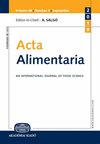Antibiotic resistance and biofilm forming abilities of Listeria monocytogenes and effect of subMIC concentration of white vinegar on these virulence factors
IF 1
4区 农林科学
Q4 FOOD SCIENCE & TECHNOLOGY
引用次数: 0
Abstract
In the present study, antibiotic resistance profiles and biofilm forming abilities of 9 Listeria monocytogenes isolates obtained from out of 30 retail meat samples were determined, and the effect of commercial white vinegar on these virulence factors in isolates exposed to subMIC concentrations were investigated. All isolates were found to be resistant to cefotixin and oxacillin, 8 isolates (26.6%) to clindamycin, 1 isolate (3.3%) to rifampicin, and 1 (3.3%) isolate was found to show intermediate resistance against clindamycin. Biofilm formation was determined for all the isolates at 22 °C and 37 °C (24 h, 48 h and 72 h). MIC values of white vinegar samples were determined at 3.12% for all isolates. MIC/2 and MIC/4 concentrations of white vinegar increased the biofilm forming capacity of the isolates by 21.2% and 17.1%, respectively. After exposure to MIC/2 concentration of white vinegar for seven days, the antibiotic resistance status of the isolates to tetracycline, rifampicin, and clindamycin changed, and the biofilm forming abilities significantly decreased at 4 °C and 37 °C for 48 h and at 37 °C for 72 h (P < 0.05). The results showed that the use of subMIC concentrations of white vinegar should be avoided in routine sanitation applications.单核增生李斯特菌的抗生素耐药性和生物膜形成能力及亚mic浓度的白醋对这些毒力因子的影响
在本研究中,测定了从30个零售肉类样品中获得的9个单核细胞增多李斯特菌分离株的抗生素耐药性和生物膜形成能力,并研究了商业白醋对暴露于亚MIC浓度的分离株中这些毒力因子的影响。所有分离株均对头孢噻新和苯唑西林耐药,8株(26.6%)对克林霉素耐药,1株(3.3%)对利福平耐药,1例(3.3%)表现出对克林霉素的中等耐药性。在22°C和37°C(24小时、48小时和72小时)下测定所有分离株的生物膜形成。所有分离株的白醋样品的MIC值均为3.12%。MIC/2和MIC/4浓度的白醋使分离株的生物膜形成能力分别提高了21.2%和17.1%。在MIC/2浓度的白醋中暴露7天后,分离株对四环素、利福平和克林霉素的抗生素耐药性发生了变化,生物膜形成能力在4 °C和37 °C 48 h和37 °C持续72 h 结果表明,在日常卫生应用中应避免使用低于MIC浓度的白醋。
本文章由计算机程序翻译,如有差异,请以英文原文为准。
求助全文
约1分钟内获得全文
求助全文
来源期刊

Acta Alimentaria
农林科学-食品科技
CiteScore
1.80
自引率
0.00%
发文量
47
审稿时长
18-36 weeks
期刊介绍:
Acta Alimentaria publishes original papers and reviews on food science (physics, physical chemistry, chemistry, analysis, biology, microbiology, enzymology, engineering, instrumentation, automation and economics of foods, food production and food technology, food quality, post-harvest treatments, food safety and nutrition).
 求助内容:
求助内容: 应助结果提醒方式:
应助结果提醒方式:


